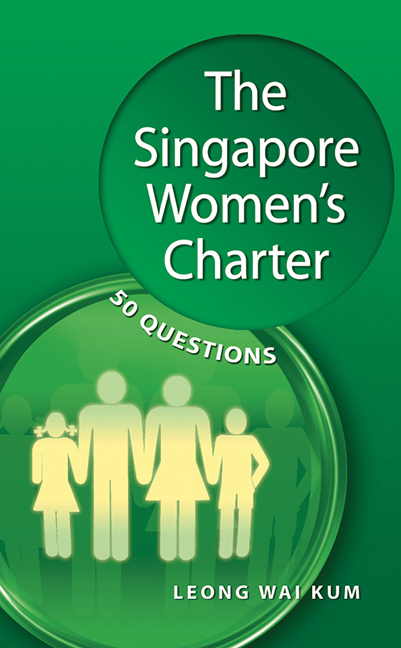Book contents
- Frontmatter
- Contents
- List of Questions
- Foreword
- Preface
- Part I What is the Women's Charter?
- Part II Marriage
- Part III Regulation of Husband-Wife Relationship
- Part IV Regulation of Parent-Child Relationship
- Part V Violence in the Family
- Part VI Divorce and the Process
- Part VII Maintenance
- Part VIII Division of Matrimonial Assets
- Part IX Muslims
- Epilogue
- References
- Index
- About the Author
Foreword
Published online by Cambridge University Press: 21 October 2015
- Frontmatter
- Contents
- List of Questions
- Foreword
- Preface
- Part I What is the Women's Charter?
- Part II Marriage
- Part III Regulation of Husband-Wife Relationship
- Part IV Regulation of Parent-Child Relationship
- Part V Violence in the Family
- Part VI Divorce and the Process
- Part VII Maintenance
- Part VIII Division of Matrimonial Assets
- Part IX Muslims
- Epilogue
- References
- Index
- About the Author
Summary
It gives me great honour to pen this message for a book on the Singapore Women's Charter. I remember living through those times before the Charter was promulgated.
The Charter was the end product of a series of events. There were many eminent individuals associated with its unfolding of whom many of us of my generation would recall the name of Mrs Shirin Fozdar. The efforts of many others should not be forgotten. To all of them, we should be thankful as the Charter represented a way forward for every woman in Singapore at that time.
Prior to the Charter, polygamy was rampant and battered spouses did not have any legal rights towards receiving protection. Undoubtedly the Charter changed much of that. The Charter also made it obligatory for a husband to maintain his wife and children during marriage and after divorce. By guaranteeing legal equality to both men and women in a marriage relationship, there was greater gender equality.
Many welcomed the Charter. But by no means did the Charter unturn gender inequality completely. If it did, there would be no reason for establishing AWARE (Association of Women for Action and Research) of which I was a founding member. For example, the Charter did not do enough to protect battered women and women whose husbands left them.
As such, the Charter was by no means perfect in its original form. In 1996, amendments were made to it — amendments critically needed to address gaps inherent in the legislation, especially to ensure greater protection to women and children.
But these amendments should not lead us to focus on the flaws of the Charter as it was crafted initially. On a more positive note, we should see the decision to amend the Charter as a reflection of society's increasing awareness of justice and equality as Singapore moves towards the 21st century.
From my own perspective as a woman activist, I am grateful for the Charter. It has brought on greater protection for women in the context of the family and, as such, greater gender equality in Singapore.
I am pleased that a book touching on this important legislation has been produced. While the effective and efficient implementation of the Charter is critical towards protecting the rights of women in marriage, a sound understanding of the Charter is also necessary.
- Type
- Chapter
- Information
- The Singapore Women's Charter50 Questions, pp. xiii - xivPublisher: ISEAS–Yusof Ishak InstitutePrint publication year: 2011



